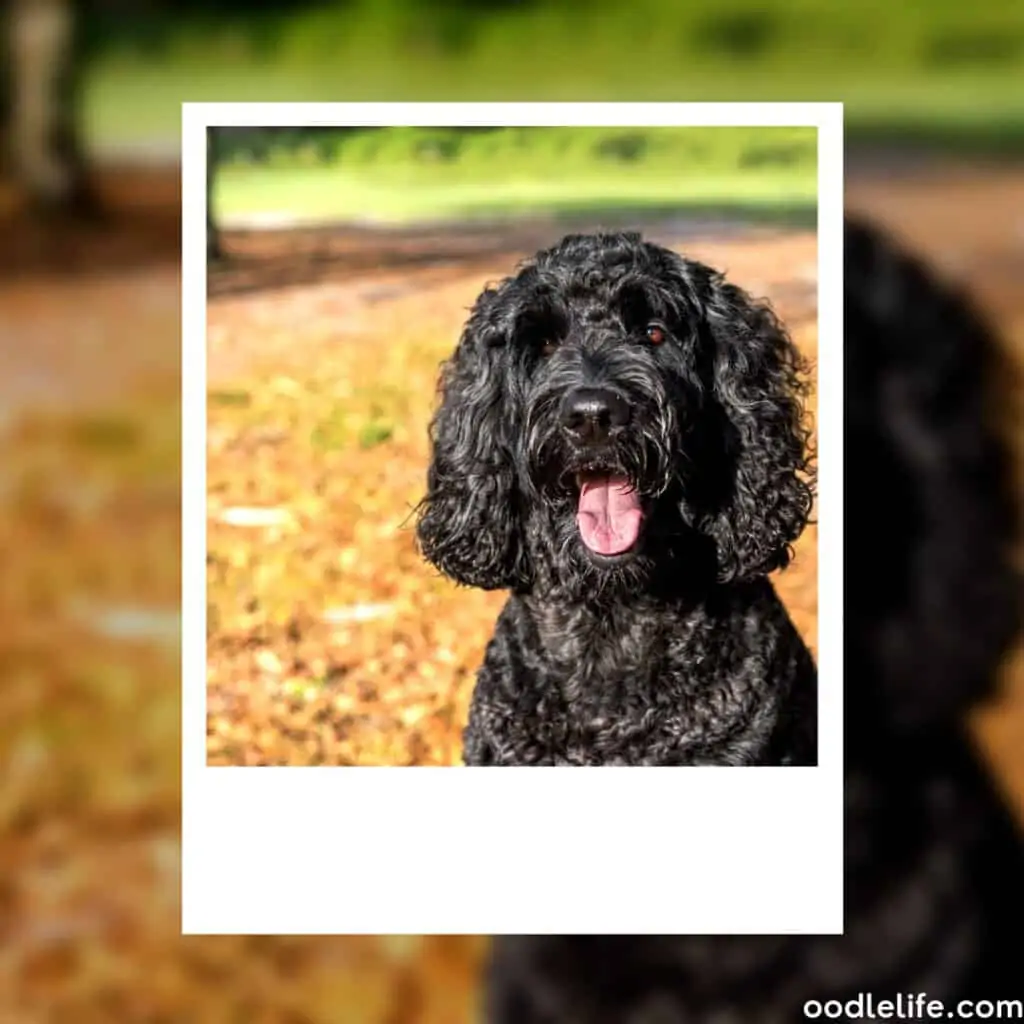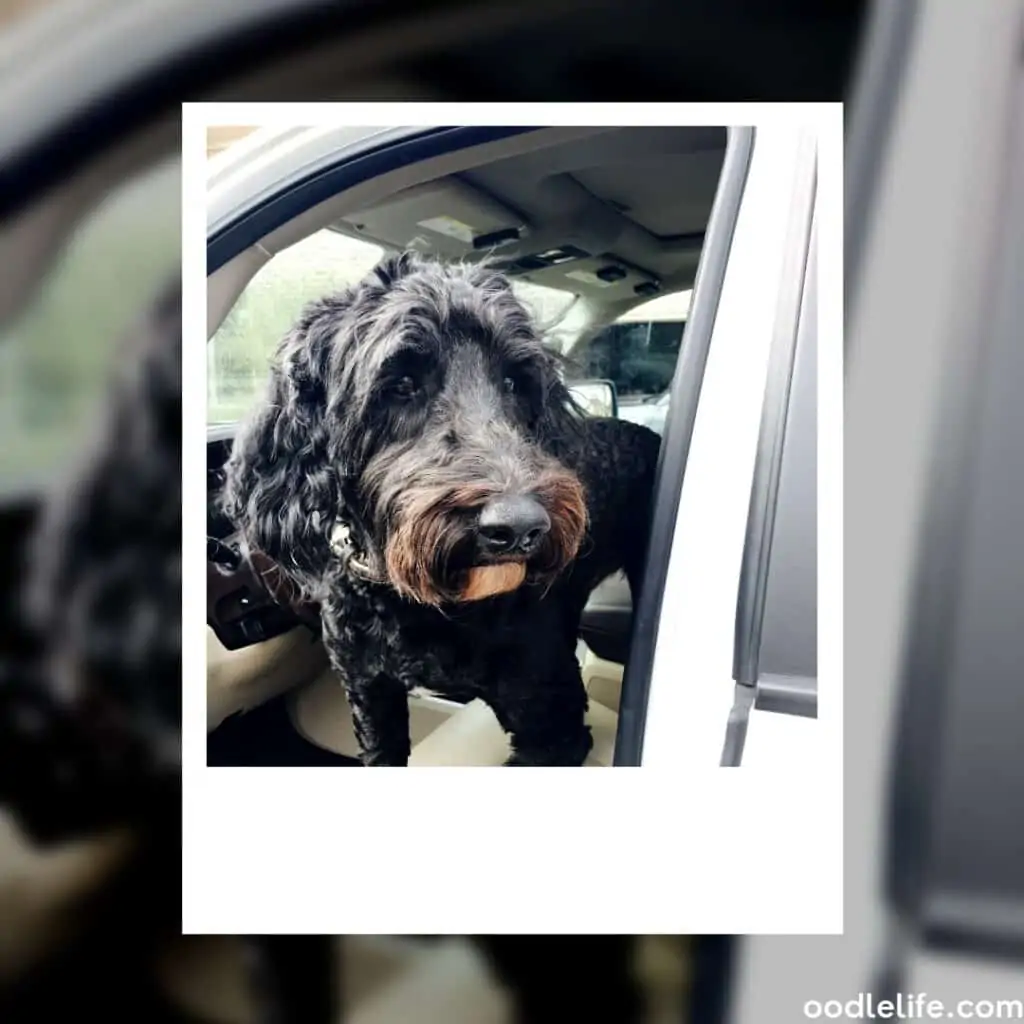Do Labradoodles Bark A Lot? [+ How to Stop Labradoodle Barking] (2024)
Labradoodles are known to be relatively calm, composed, and super friendly. But do Labradoodles bark a lot?
Contrary to what some might expect, Labradoodles are not excessive barkers. They tend to bark with purpose rather than habitually, placing them in the mild-barker category.
Their barking can often be attributed to reasons such as seeking attention, expressing excitement, or responding to unfamiliar stimuli.
They usually bark for a reason.

Labradoodles are quickly becoming a favorite dog breed for first-time owners. I have never met a dog quite like our Miniature Labradoodle Max. He is amazing!

Reasons for a Labradoodle to Bark

All dog barks. It is part of being a dog. It is also one of their ways to tell you something.
A dog that doesn’t bark is more concerning than one that does, even if it is too loud.
Asking your dog to not bark is like asking a person to stop talking. So within reason, it is perfectly fine for your Labradoodle to woof. You need to learn how to decipher what is causing the yapping. And identify whether it is within reason or something for you to worry about.
And again, since Labradoodles are medium barkers, knowing the common reasons for their dog shouting can come in handy.
Attention-Grabbing Yapping
Like you and all the rest of the creatures here on the planet, if you feel like you are being ignored or neglected, you will do something about it. If you have not spent much time with your Labradoodle, you will observe some of its behaviors that are aimed to get your attention. It might become annoyingly playful where it starts stealing your shoes. Your furbaby might even chew on some furniture. This is all because it is trying to tell you, “Hey Hooman, I’m right here! Come notice me!”
Along with these behavioral shifts is barking whenever you are within proximity. When your dog barks, your first reaction is to stop and find out what’s wrong. You even ask your dog, “Hey bud, what’s wrong?”
Your Labradoodle will then get this as instant attention and will start “acting out” more so that you are completely focused on your lonely canine. For your dog, it is a fix for being ignored.
The Case of Night Barking
Labradoodles are not keen night barkers, which is good, but if they start becoming one, there might be some things triggering it.
Medical condition: Sick Labradoodles and the older ones suffering age related degeneration can eventually turn into night barkers. Like our elderly, when everything’s dark, they may get confused with their surroundings. Pair that with failing eyesight, and every shadow and rustle means Red Alert.
Boredom alert: Like kids, sometimes it is hard to make your Labradoodle understand that when the clock strikes 10 PM, then it’s everybody’s bedtime – dog included. With no people to interact with, out of boredom, your naughty Labradoodle might start barking for no reason at all. (Are you walking and exercising your Labradoodle enough?)
Separation anxiety: This may be true for Labradoodles as well as any other kind of dog who is yet to become comfortable in your new home or Labradoodles who have been in an abusive home before. Labradoodles are very social and love a cuddle.
Legit disturbances: If night-time barking has become a pattern, it’s time to consider that maybe some disturbances are happening outside that’s causing your Labradoodle to go into a yapping fit. This can be night critters, raccoons, or cats that are making a habit of visiting your home when night falls, or even some nefarious people outside. Don’t take your doggo’s night-barks too lightly.
Fear of thunderstorms: Labradoodles are very sensitive to flashes and loud noises, and thunderstorms include both of these. Expect that during lightning and thunderstorms, your Labradoodle will feel scared and will have an unstoppable woofing episode. Dogs can also get nightmares.
Excitement to the Highest Level
This is barking for joy! It’s when your Labradoodle gets extremely excited! It may be because it hasn’t seen you for a while, or a buddy has come over, or there’s a new toy, then it’s time for some happy-yapping. Don’t worry. Once your best friend calms down, the barking will also stop.
Barking to Protect
Your Labradoodle may protect you or it may be protecting itself from something that it feels is a threat. Barking is your loyal dog’s way of giving you a warning that something is not right or a warning to the danger to back off. Additionally, this breed also has a penchant for barking at people walking by. The overwhelming number of unknown faces may cause your dog to give a loud warning of its presence.

Hey, Unfamiliar Faces!
New faces of family, friends, and guests may warrant some unnecessary woofing from a Labradoodle. Initially, the unfamiliar faces are seen as risks to their human family, but after settling down and having seen that they are welcomed, your Labradoodle will calm down but may still be on high-alert.
What Can You Do To Minimize Labradoodle Barking?

Dogs are supposed to bark, so let them be. But excessive and unreasonable barking is something that certainly needs to be corrected.
Here are things you can do to reduce your Labradoodle’s yapping and make it more understandable:
Easy Ways to Train Your Labradoodle Not to Bark
You can train your Labradoodle to develop good barking habits. In fact, with consistent effort, you can even have your Labradoodle bark only when necessary.
There are many methods that Labradoodle trainers and owners use, but below is a 3-step method that is known to help with too much barking. This may not be the top favorite because it involves ignoring your Labradoodle, but the method is proven to be effective.
Training Step 1 – Ignore Your Labradoodle’s Barking
If you know that the barking is without an acceptable reason, then decide to ignore it. Yes, even if you get frustrated and angry, turn a deaf ear and pretend that you do not hear anything.
Don’t even glance in the direction of your Labradoodle. Continue ignoring your dog even if it takes hours at a time. It will require some patience on your part (and having to harden your heart if you just can’t ignore your doggo’s woofs) but it is something you must-do if you wish to properly train your dog.
Training Step 2 – Give Due Recognition
After a yapping episode, your Labradoodle will also get tired and will stop on its own. When this happens, give your dog all your attention.
As soon as it stops barking, it is time to give some treats and plenty of praise and cuddles.
Training Step 3 – Do the Cycle
Continuous reinforcement is essential. There should be no exemptions on your part to not do this religiously.
You will notice that the woofing episodes will start getting shorter. Since Labradoodles are naturally intelligent, they will pick up on the pattern that it gets to be the center of attention when it doesn’t bark unnecessarily and will soon dial down its bark-attacks.

Additional Tips and Tricks for a Barking Labradoodle
Never show anger toward your dog for its barking. Again, barking is your dog’s way of talking, so it doesn’t deserve to be reciprocated with anger. And never physically punish your doggo for any reason! Showing anger toward your dog can lead to fear and even aggression in them.

Establish a routine for your Labradoodle. This will allow adequate enrichment and assurance to your furbaby when it is left alone.
If your Labradoodle is barking for attention, make sure that it doesn’t receive any attention until they are calm and quiet. This needs to be a consistent practice.
Place your Labradoodle in a more conducive environment where there’ll be fewer triggers. If your dog usually spends time in the yard facing the street where the unfamiliar passers-by can trigger a woofing episode, then try having your dog in the back of the house.
Teach the “bark and quiet” command to your dog. Or you can pair “quiet” with a settling command like “Sit” or “Down.”
FAQ: When Should I Use a No Shock Bark Collar for My Labradoodle?

Q: I’ve heard about non-shock bark collars as a training tool. When is it appropriate to use one for my Labradoodle’s barking behavior?
A: Non-shock bark collars are designed to provide a gentle deterrent to excessive barking without delivering an electric shock. Instead, they might use vibrations, sounds, or citronella sprays. Here’s when to consider using one:
- After Basic Training: Before resorting to any collar, ensure you’ve attempted basic bark training methods, such as the “quiet” command or diversion tactics.
- Rule Out Underlying Issues: Ensure your Labradoodle’s barking isn’t due to pain, anxiety, or other health concerns. It’s essential to understand the root cause of the barking.
- Positive Reinforcement First: Always pair the collar’s deterrent with positive reinforcement. When your dog stops barking, reward them with praise or a treat.
- Supervised Use: Initially, only use the collar when you can supervise its effects, ensuring it’s functioning correctly and not causing distress.
- Not as a First Resort: The collar should not be the first method tried. Instead, consider it as an option if other training techniques haven’t been effective.
A quality no shock bark collar won’t bust the budget. The best bark collar for most Labradoodles is this simple one.
Remember, a non-shock bark collar is just one tool among many. It’s essential to ensure it’s used humanely and effectively, understanding your Labradoodle’s needs and behavior. If in doubt, consult with a professional dog trainer or veterinarian for personalized advice.
Do Australian Labradoodle dogs bark alot?
There is a difference between a Labradoodle and the Australian Labradoodle breed. There is a whole extra type of genetics in there! The temperament and barking issues faced by both are similar though. So the simple steps to overcome a Labradoodle puppy that barks are the same for the Aussie Labradoodle.
Both are “designer dog” breeds (which really just means hybrid dogs).
Both are highly social so be mindful of acting out behavior or barking caused by separation anxiety. This trait is true of many Doodle dogs.

FAQ: How to Stop Senile Barking in Labradoodles?
Q: My older Labradoodle has started barking more often without any apparent reason. Could this be senility, and how can I manage it?
A: Yes, older dogs, including Labradoodles, can exhibit increased barking due to cognitive decline or senility, known as Canine Cognitive Dysfunction (CCD). This is somewhat akin to dementia in humans. Here’s how to manage senile barking:
- Visit the Vet: Always consult with your veterinarian first to rule out potential health issues that might be causing increased barking.
- Create a Routine: Dogs with CCD benefit from a structured routine, as predictability can help reduce anxiety and confusion.
- Provide Mental Stimulation: Engage your Labradoodle in gentle but mentally stimulating activities. Puzzle toys or simple training exercises can help.
- Medication: In some cases, veterinarians might prescribe medication to manage symptoms of CCD.
- Comfortable Environment: Ensure your dog has a comfortable resting place, and consider using calming products, like pheromone diffusers or calming wraps, to help reduce anxiety.
- Patience: Understand that your dog is not barking on purpose or to be defiant. It’s a result of age-related changes. Be patient, gentle, and consult with professionals for guidance.
Addressing senile barking requires a blend of patience, understanding, and proactive care to ensure the well-being of your aging Labradoodle.
FAQ: Do Labradoodles Howl?
Q: Do Labradoodles have a tendency to howl?
A:While both parent breeds aren’t particularly known for howling, like some hound breeds are, any dog, including Labradoodles, might howl occasionally. Reasons can vary, from responding to certain noises (like sirens), to seeking attention, to expressing discomfort or anxiety.
A Labradoodle howl sounds closer to a Labrador howl than a Poodle “howl”.
However, it’s not a characteristic behavior for the breed. If your Labradoodle howls frequently, it may be a good idea to investigate the underlying cause to ensure your pet’s well-being.
Final Labradoodle Barking Thoughts
Labradoodles are natural barkers, like all dogs, but they don’t make it a nuisance habit.
Most of the time, they bark within reason as it is also a means of serving their purpose as dogs. But when you observe that they seem to be yapping to draw attention or are developing an unwanted behavior, then make sure that you take the necessary actions to correct it.
Labradoodles are bright, so you can incorporate training to address their behavior. Overall, a Labradoodle dog makes an excellent pet, and their barking will almost always just be another thing you’ll adore them for!
